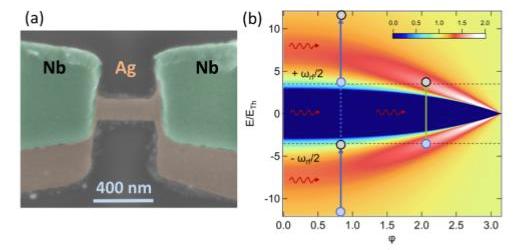
Credit: University of Jyväskylä/Pauli Virtanen
Understanding how microwave absorption changes the transport properties of diffusive Josephson junctions is at the forefront of interest in the quantum transport community. It is especially relevant for the current efforts to address the current-phase relation in topological Josephson junctions and more generally the microwave transport in quantum devices. Researchers from the University of Paris-Saclay, the University of Regensburg (Germany) and the University of Jyvaskyla; (Finland) have delivered a combined experimental and theoretical work which reveal the profound nature of quantum transport in strongly driven diffusive Josephson junctions. Results are published in Physical Review Research in October.
At sufficiently low temperatures, superconductors cannot absorb microwave radiation of energy smaller than the superconducting energy gap D. In Josephson weak links instead, where two superconductors (S) are weakly coupled through a long diffusive metallic wire (N), radiation can be absorbed in N because the induced gap in the density of states or minigap is considerably smaller than D.
In a recent article the researchers’ team have studied the out-of-equilibrium dynamical state induced by the absorption of high frequency microwave photons in diffusive Superconductor-Normal metal-Superconductor (SNS) junction. To characterize this state, the researchers pioneered a harmonic-resolved ac-Josephson spectroscopy technique which allows to access the harmonic content of the current-phase relation under microwave radiation.
With this approach, which does not require a specialized on-chip circuitry, they could see that a strong anharmonicity of the current-phase relation arises under illumination, especially at high frequency when inelastic transitions across the induced minigap are favored. This novel regime goes well beyond the standard Eliashberg theory and is understood because of the modifications of the supercurrent-carrying Andreev spectrum induced by non-adiabatic transitions.
These findings shed light on the complex mechanisms involved in irradiated mesoscopic superconductors and has important implications in Andreev-based quantum computing prospects.
###
Link to the article in Physical Review Research 1, 032009 (2019): https:/
For further information:
Professor Tero Heikkilä, University of Jyvaskyla;, Finland, [email protected], tel. +358408054804
University researcher Pauli Virtanen, University of Jyvaskyla, Finland, [email protected]
Communications officer Tanja Heikkinen, [email protected], tel +35850 581 8351
Media Contact
Tero Heikkilä
[email protected]
358-408-054-804
Original Source
https:/
Related Journal Article
http://dx.




